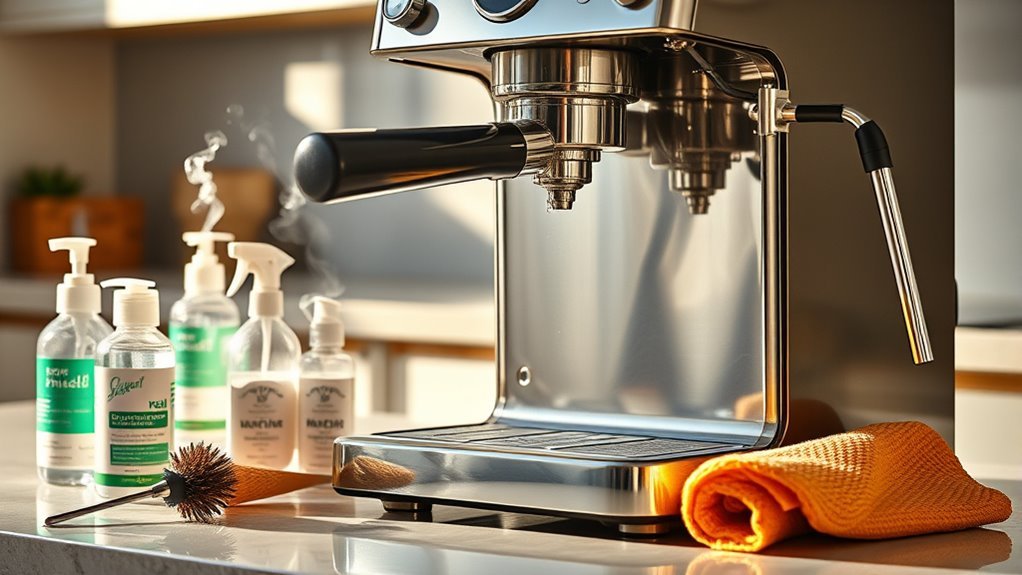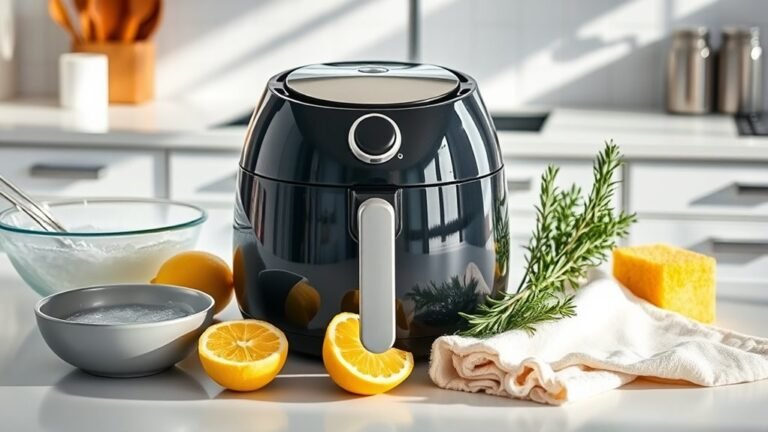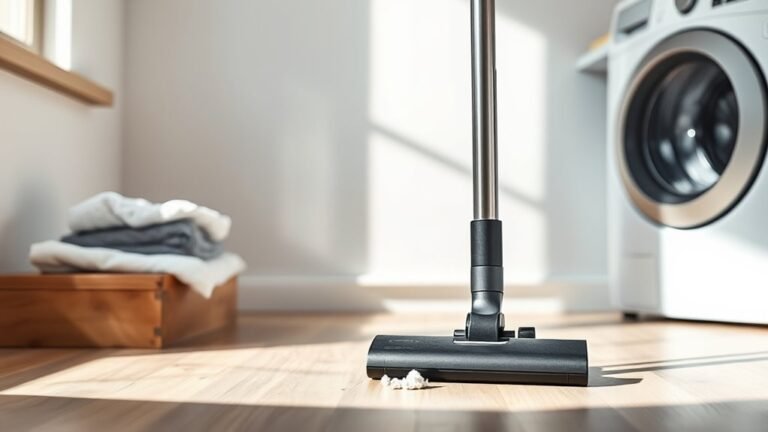Cleaning Techniques for Coffee Machine Owners
To keep your coffee machine brewing great, rinse removable parts like the carafe and water reservoir daily to prevent buildup and bacteria. Wipe the exterior and clean the drip tray to avoid mold. Descale monthly with a vinegar solution or commercial cleaner to remove mineral deposits slowing brewing. Don’t forget to soak and brush portafilters regularly, and flush group heads to clear oils and grounds. Following these steps protects flavor and machine longevity—there’s plenty more detail to help you master maintenance.
Identifying Common Coffee Machine Residues
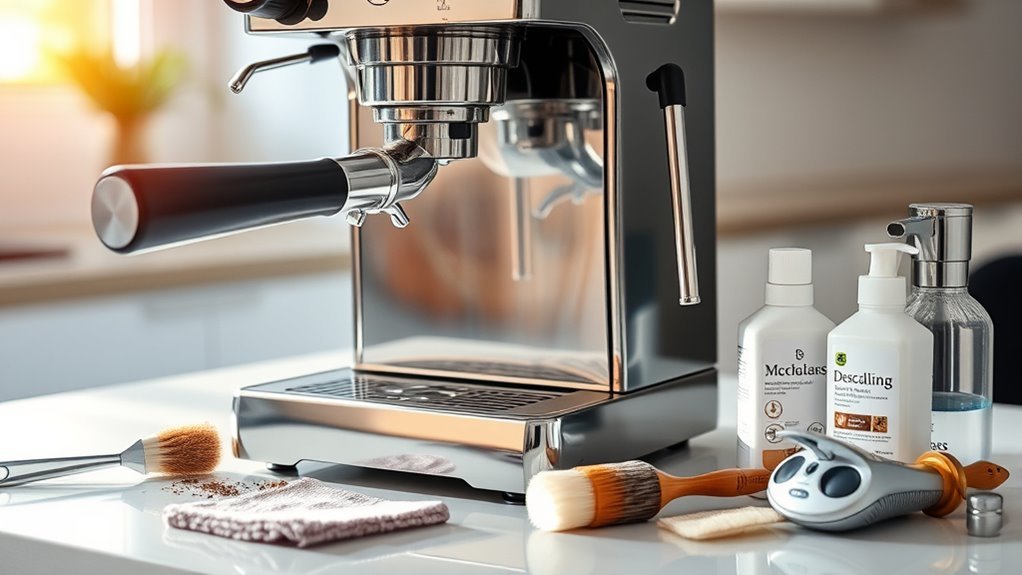
Residue buildup is the main culprit behind reduced coffee machine performance, and knowing what to look for can save you time and effort during cleaning. You’ll often find stubborn coffee oil coating internal parts, which not only dulls flavor but can also trap dirt and bacteria. Over time, this oily film darkens and becomes sticky, making it tougher to remove. Another concern is mold growth, especially in damp areas like water reservoirs or drip trays. Mold can appear as fuzzy spots or slimy layers, compromising both taste and your health. Being vigilant about these residues lets you target problem areas effectively, ensuring your machine runs smoothly and your coffee stays fresh. Recognizing these common residues is your first step toward maintaining freedom from breakdowns and stale brews.
Daily Cleaning Practices for Coffee Makers
You should make rinsing removable components part of your daily routine to prevent buildup and maintain flavor integrity. Wiping down external surfaces with a damp cloth helps remove oils and dust, keeping your machine looking sharp. These simple steps guarantee your coffee maker stays clean and functions smoothly every day.
Rinsing Components Regularly
Although it might seem like a small step, rinsing your coffee machine’s components daily is crucial for maintaining peak performance and flavor. Regular rinsing prevents residual coffee oils and grounds from building up, which can quickly degrade taste and clog your machine. Focus on parts like the filter basket, carafe, and removable water reservoir—these need thorough rinsing with warm water to remove any leftover debris. This simple act of component maintenance guarantees your machine operates smoothly and extends its lifespan. By incorporating this daily habit, you’re not just preserving the quality of each brew but also freeing yourself from future, more intensive cleanings. Prioritize regular rinsing to enjoy a consistently fresh cup and keep your coffee routine hassle-free.
Wiping External Surfaces
Keeping the interior parts clean is just one side of maintaining your coffee maker. To guarantee lasting performance and a fresh look, you need to focus on external cleanliness daily. Start by identifying the surface materials—whether stainless steel, plastic, or glass—as each requires specific care. Use a soft, damp cloth with mild detergent for plastic and glass surfaces to remove fingerprints and spills without causing damage. For stainless steel, a microfiber cloth paired with a gentle cleaner helps maintain that sleek finish and prevents streaks. Avoid abrasive tools that could scratch or dull the exterior. By routinely wiping down your coffee maker’s external surfaces, you not only uphold its appearance but also reduce dust and grime buildup, giving you the freedom to enjoy your brew without worry.
Descaling Techniques to Remove Mineral Buildup
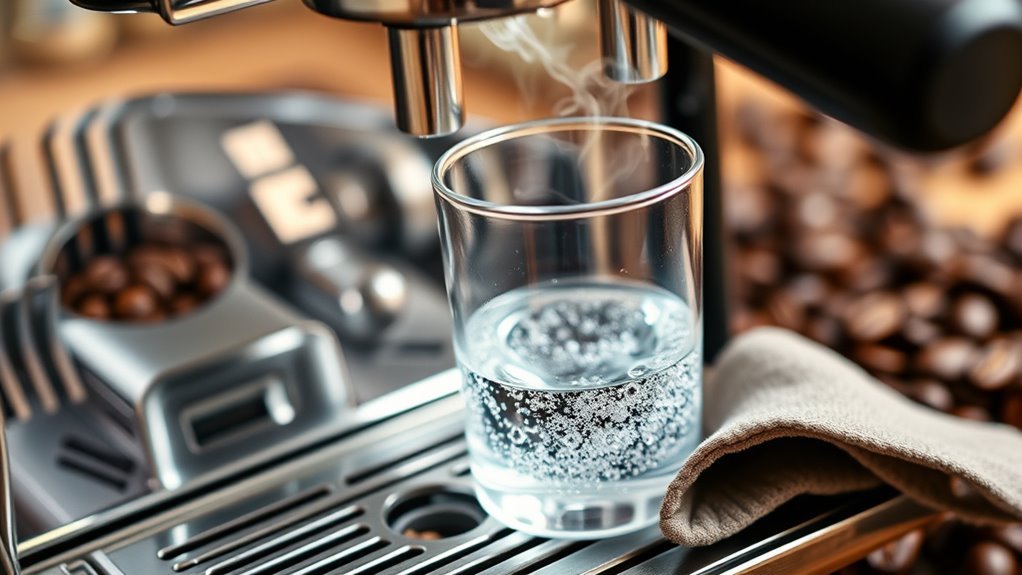
You’ll know it’s time to descale your coffee machine when you notice slower brewing, unusual noises, or mineral deposits on the heating elements. Using effective descaling solutions like citric acid or commercial descalers can break down these buildups safely. Follow a step-by-step process to guarantee thorough cleaning without damaging your machine.
Signs of Mineral Buildup
Several clear signs can indicate mineral buildup in your coffee machine, signaling it’s time for descaling. Recognizing these mineral indicators helps you maintain peak performance and guarantees buildup prevention. Watch for slower brewing, unusual noises, or strange tastes. Ignoring these signs can reduce your machine’s lifespan.
| Sign | Description | Impact on Coffee Machine |
|---|---|---|
| Slow Brewing | Water flows sluggishly | Efficiency drops |
| Strange Noises | Grinding or whistling sounds | Mechanical strain |
| Off Taste | Bitter or metallic flavors | Compromised coffee quality |
Effective Descaling Solutions
Although mineral buildup can be stubborn, choosing the right descaling solution makes all the difference in restoring your coffee machine’s performance. You have two main options: a vinegar solution or commercial descalers. A vinegar solution is budget-friendly and effective for mild buildup, using a mixture of equal parts white vinegar and water. However, its strong smell may linger, so rinse thoroughly. Commercial descalers are formulated specifically for coffee machines, offering a faster, odorless, and often more thorough clean. They’re designed to dissolve calcium and lime deposits without harming internal components. Whichever you choose, verify the product suits your machine’s material to avoid damage. Selecting the right descaling solution empowers you to maintain your coffee machine’s freedom to deliver rich, flavorful coffee every day.
Step-by-Step Descaling Process
A thorough descaling process typically involves five key steps that restore your coffee machine’s efficiency by removing mineral buildup. First, unplug your machine and empty any water from the reservoir. Next, prepare a descaling solution—either a commercial product or a mix of equal parts water and white vinegar. Pour the solution into the reservoir, then run a brewing cycle without coffee grounds to allow the solution to circulate. Afterward, flush the system by running several cycles with clean water to clear out any residue. Finally, wipe down all accessible parts and reassemble your machine. Sticking to a regular descaling frequency based on your water hardness and usage is essential for effective coffee machine maintenance, ensuring your machine runs smoothly and your coffee tastes just right.
Deep Cleaning Methods for Espresso Machines
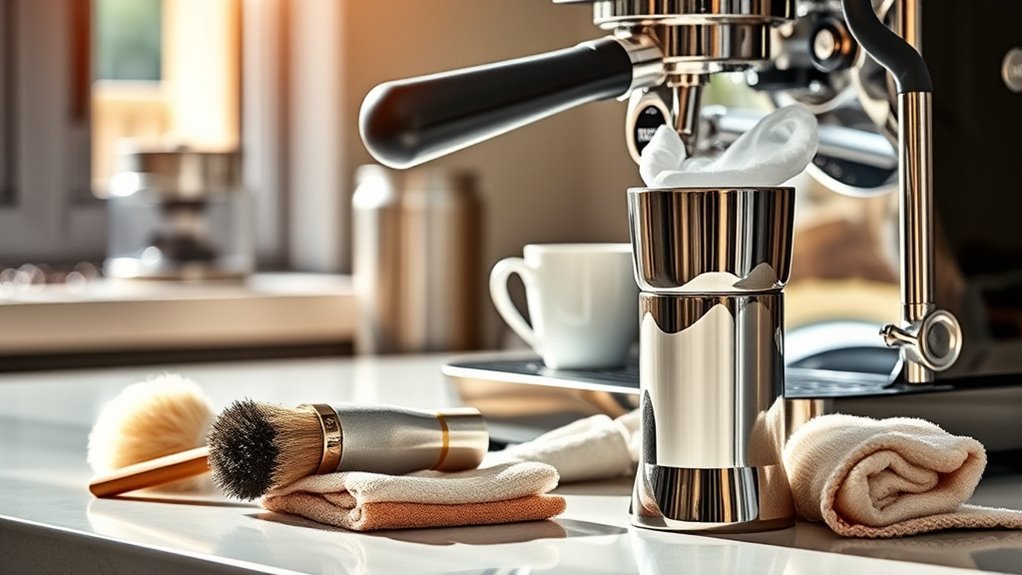
When you want to maintain the ideal performance and flavor quality of your espresso machine, deep cleaning is essential. Start by focusing on brew group maintenance—remove coffee grounds and oils that build up over time using a specialized brush and cleaning detergent. This prevents blockages and guarantees consistent extraction. Next, pay close attention to steam wand sanitation: purge and wipe the wand after every use, then soak removable tips in hot water with a milk-cleaning solution to eliminate residual milk proteins that can harbor bacteria. Don’t forget to flush water through the group head to clear any trapped debris. Regularly performing these steps not only prolongs your machine’s lifespan but also assures each espresso shot delivers the pure, robust flavor you crave, giving you the freedom to enjoy barista-quality coffee at home.
Cleaning Removable Parts and Filters
Maintaining the cleanliness of your espresso machine’s removable parts and filters is just as important as keeping the brew group and steam wand in top shape. Regular filter maintenance prevents clogs and guarantees a smooth extraction, while cleaning removable parts like drip trays and water reservoirs avoids bacterial buildup. So, take them apart gently and soak in warm, soapy water, then rinse thoroughly.
| Part | Cleaning Frequency | Recommended Method |
|---|---|---|
| Portafilter | After every use | Soak and brush |
| Filters | Weekly | Descale and rinse |
| Drip Tray | Daily | Wipe and sanitize |
| Water Reservoir | Weekly | Wash and air dry |
| Shower Screen | Monthly | Remove and soak |
Staying consistent with filter maintenance and removable parts cleaning keeps your machine reliable and your coffee delicious.
Tips for Maintaining Coffee Machine Hygiene
Because coffee machines are prone to residue buildup and bacterial growth, you should adopt a consistent hygiene routine that goes beyond basic cleaning. Regularly flush the machine with hot water to clear hidden oils that dull your coffee flavor. Wipe down exterior surfaces and the drip tray daily to prevent mold and bacteria. Deep clean internal components monthly using manufacturer-recommended descaling solutions, which protect your machine’s longevity by preventing mineral buildup. Don’t forget to replace water filters as advised to keep water pure and tasting fresh. By maintaining these habits, you guarantee each cup delivers peak flavor while extending your coffee machine’s life, giving you freedom from frequent repairs or replacements. A disciplined hygiene routine is key to enjoying rich, clean coffee effortlessly every day.
Frequently Asked Questions
Can I Use Vinegar Instead of Commercial Descaling Products?
You can use vinegar as a descaling alternative because it’s affordable and effective at breaking down mineral buildup. Vinegar benefits include natural acidity that dissolves limescale, making it a popular DIY choice. However, be cautious since its strong smell can linger, and it might damage some machine parts over time. If you want freedom from pricey products, vinegar’s great—but always check your coffee maker’s manual first to avoid voiding warranties.
How Often Should I Replace the Water Filter in My Coffee Machine?
You should replace your water filter based on its water filter lifespan, which typically ranges from 2 to 3 months, depending on usage. The filter replacement frequency can vary if you brew coffee daily or use hard water. Staying on top of this helps maintain water purity and prolongs your machine’s life. Keep an eye on your machine’s alerts or manufacturer guidelines to guarantee you’re replacing filters at the right time, giving you freedom from tasting impurities.
Is It Safe to Clean Coffee Machines in a Dishwasher?
Think of your coffee machine like a delicate watch—just tossing it in the dishwasher might seem convenient, but it risks damage. Dishwasher safety varies depending on your machine’s parts; plastic or metal components may warp or corrode. Always check manufacturer guidelines before using harsh cleaning materials or the dishwasher. To keep your coffee machine in top shape without risking damage, hand-washing removable parts with mild detergent is usually your safest bet.
What Are the Best Cleaning Products for Stainless Steel Coffee Machines?
When looking for the best stainless steel cleaners, you want something gentle yet effective to avoid scratching your coffee machine. Opt for non-abrasive, pH-balanced products specifically designed for stainless steel surfaces. Using these in your coffee machine maintenance routine keeps the exterior shiny and free from fingerprints. Avoid harsh chemicals; instead, try natural options like vinegar diluted with water for a safer, eco-friendly clean that lets you enjoy your brew with freedom and confidence.
How Do I Prevent Mold Growth Inside My Coffee Machine?
Mold means mischief—maintain mold prevention by regularly rinsing and drying your coffee machine parts. To guarantee coffee hygiene, always empty the water reservoir after use and clean the drip tray frequently. Use vinegar or specialized cleaners monthly to dissolve stubborn buildup. Keeping your machine dry and clean lets you savor fresh brews freely, without the fear of funky flavors or fungal growth sabotaging your daily coffee ritual.
